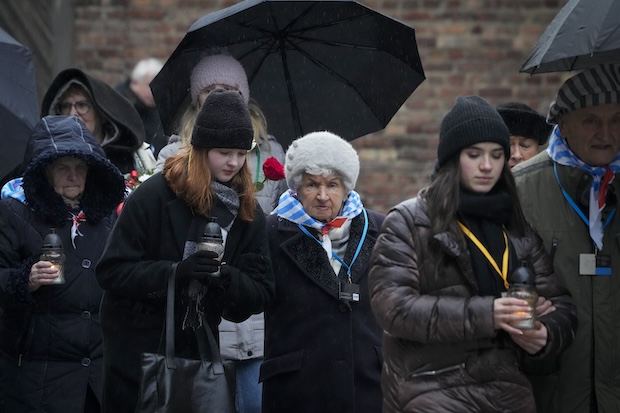Nazi death camp survivors mark 79th anniversary of Auschwitz liberation

OSWIECIM, Poland — A group of survivors of Nazi death camps marked the 79th anniversary of the liberation of the Auschwitz-Birkenau camp during World War II in a modest ceremony Saturday in southern Poland.
About 20 survivors from various camps set up by Nazi Germany around Europe laid wreaths and flowers and lit candles at the Death Wall in Auschwitz.
Later, the group will hold prayers at the monument in Birkenau. They were memorializing around 1.1 million camp victims, mostly Jews. The memorial site and museum are located near the city of Oswiecim.
Nearly 6 million European Jews were killed by the Nazis during the Holocaust — the mass murder of Jews and other groups before and during World War II.
Marking International Holocaust Remembrance Day, the survivors will be accompanied by Polish Senate Speaker Malgorzata Kidawa-Blonska, Culture Minister Bartlomiej Sienkiewicz, and Israeli Ambassador Yacov Livne.
READ: ‘No expiry date’ for justice, says key lawyer on twilight Nazi trials
The theme of the observances is the human being, symbolized in simple, hand-drawn portraits. They are meant to stress that the horror of Auschwitz-Birkenau lies in the suffering of people held and killed there.
Article continues after this advertisementHolocaust victims were commemorated across Europe.
Article continues after this advertisementREAD: Germany puts 100-year-old on trial for Nazi crimes
In Germany, where people put down flowers and lit candles at memorials for the victims of the Nazi terror, Chancellor Olaf Scholz said that his country would continue to carry the responsibility for this “crime against humanity.”
He called on all citizens to defend Germany’s democracy and fight antisemitism., as the country marked the anniversary of the liberation of Auschwitz.
“Never again’ is every day,” Scholz said in his weekly video podcast. “Jan. 27 calls out to us: Stay visible! Stay audible! Against antisemitism, against racism, against misanthropy — and for our democracy.”
Ukrainian President Volodymyr Zelenskyy, whose country is fighting to repel Russia’s full-scale invasion, posted an image of a Jewish menorah on X, formerly known as Twitter, to mark the remembrance day.
“Every new generation must learn the truth about the Holocaust. Human life must remain the highest value for all nations in the world,” said Zelenskyy, who is Jewish and has lost relatives in the Holocaust.
“Eternal memory to all Holocaust victims!” Zelenskyy tweeted.
In Italy, Holocaust commemorations included a torchlit procession alongside official statements from top political leaders.
Italian Premier Giorgia Meloni said that her conservative nationalist government was committed to eradicating antisemitism that she said had been “reinvigorated” amid the Israel-Hamas war. Meloni’s critics have long accused her and her Brothers of Italy party, which has neo-fascist roots, of failing to sufficiently atone for its past.
Later Saturday, leftist movements planned a torchlit procession to remember all victims of the Holocaust — Jews but also Roma, gays and political dissidents who were deported or exterminated in Nazi camps.
Police were also on alert after pro-Palestinian activists indicated that they would ignore a police order and go ahead with a rally planned to coincide with the Holocaust commemorations. Italy’s Jewish community has complained that such protests have become occasions for the memory of the Holocaust to be co-opted by anti-Israel forces and used against Jews.
In Poland, a memorial ceremony with prayers was held Friday in Warsaw at the foot of the Monument to the Heroes of the Ghetto, who fell fighting the Nazis in 1943.
Earlier in the week, the countries of the former Yugoslavia signed an agreement in Paris to jointly renovate Block 17 in the red-brick Auschwitz camp and install a permanent exhibition there in memory of around 20,000 people who were deported from their territories and brought to the block. Participating in the project will be Bosnia and Herzegovina, Croatia, Montenegro, North Macedonia, Serbia and Slovenia.
Preserving the camp, a notorious symbol of the horrors of the Holocaust, with its cruelly misleading “Arbeit Macht Frei” (“Work Makes One Free”) gate, requires constant effort by historians and experts, and substantial funds.
The Nazis, who occupied Poland from 1939-1945, at first used old Austrian military barracks at Auschwitz as a concentration and death camp for Poland’s resistance fighters. In 1942, the wooden barracks, gas chambers and crematoria of Birkenau were added for the extermination of Europe’s Jews, Roma and other nationals, as well as Russian prisoners of war.
Soviet Red Army troops liberated Auschwitz-Birkenau on Jan. 27, 1945, with about 7,000 prisoners there, children and those who were too weak to walk. The Germans had evacuated tens of thousands of other inmates on foot days earlier in what is now called the Death March, because many inmates died of exhaustion and cold in the sub-freezing temperatures.
Since 1979, the Auschwitz-Birkenau site has been on the UNESCO list of World Heritage.